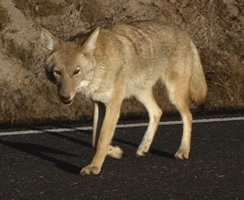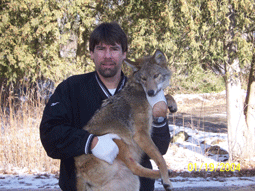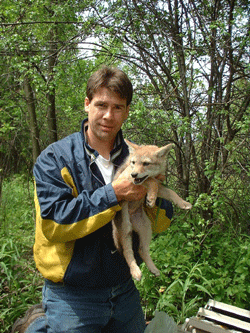Windy City Wileys
Air Date: Week of January 13, 2006

(Courtesy of University of Toledo)
Long the bane of farmers and ranchers, coyotes have been taking up residence in cities, where most of their human neighbors don’t even know of their existence. Chicago is one of their new stomping grounds. It’s thought that several thousand of the animals are now living in the Windy City. Host Bruce Gellerman talks with researcher Stanley Gehrt.
Transcript
GELLERMAN: If you live in the city, that mangy looking dog you spotted prowling through your backyard last night just might not be a dog. Seems coyotes are taking up residence in urban areas across the nation. And the influx has come as a big surprise to people in Chicago. Several thousand of the wild canines have taken a liking to the Windy City. Stanley Gehrt, assistant professor of environmental and natural resources at Ohio State University, has been studying the Chicago coyotes for six years. Professor, thanks for your time.
GEHRT: It’s a pleasure to be here.
GELLERMAN: What’s the biggest problem that coyotes have caused in, say, Chicago?
GEHRT: Well, unfortunately, there are conflicts that occur in certain cases between coyotes and people. And the most severe, potentially, could be when coyotes may attack a person. That’s been extremely rare across the Midwest and eastern part of the U.S. So, that’s the biggest concern, is fear for, primarily, children.
They do occasionally take housecats, especially. And then every once in a while you will have some that will take smaller dogs. Or, in the rare event, they may actually even attack large dogs, given certain circumstances.
GELLERMAN: Any upside on having coyote in cities?
GEHRT: We have found at least three different benefits that we have in terms of coyotes living with us. One would be they do have an impact on rodent populations. They also are the major predators of white-tailed deer fauns. And then, most recently, we’ve discovered that coyotes are major predators on Canada goose nests. And Canada geese, that’s another species that becomes a nuisance in urban areas.
GELLERMAN: Coyotes are kind of timid, I thought. You know, you look at their faces. I’ve seen pictures and they kind of look scared.

Stan Gehrt holds an immobilized adult coyote from the Chicago metro area. (Courtesy of Max McGraw Wildlife Foundation)
GELLERMAN: If coyotes are so wily, it must be very difficult to trap them.
GEHRT: It’s incredibly difficult. That’s one of the biggest challenges of any kind of research on coyotes, but particularly so in urban areas because we have to use many of the same traps that regular fur trappers might use such as leg-hold traps that are padded so they don’t hurt the animals, or cable-restraint devices, such as snares, with stops so that they don’t choke on them. But in urban areas, it’s complicated even more so by pets and other animals, such as the abundant raccoon.
GELLERMAN: Well, how were you able to track them?
GEHRT: We use radio collars and technology to try to follow them.
GELLERMAN: So, Professor Gehrt, if I understand correctly, you put these radio collars on them, they send out a beacon, and you track the beacon?
GEHRT: Right. We actually have two different types. We have one type that we call VHF which we follow with a truck with an antenna on top of it, which gets a lot of strange looks from people in downtown Chicago, but –
GELLERMAN: The Coyote Mobile!
GEHRT: (LAUGHS) Exactly. So we have that type of radio collars, and then we have a different type that actually transmits signals to satellites. And so the satellites can locate the coyotes for us and then we can download the data from the satellites.

Stan Gehrt holds an immobilized adult coyote from the Chicago metro area. (Courtesy of Max McGraw Wildlife Foundation)
GEHRT: Many of them will hide either in natural habitat, if any exists, such as in certain parks or golf courses or cemeteries. And then others may use people’s sheds, they may crawl under the decks behind their houses, or similar things like that.
GELLERMAN: Coyotes, they’re noisy, right? They howl?
GEHRT: We have some packs that howl frequently, and then we others that we’ve never heard them howl at all. We used to think that there’s a lot of residential area, and they’re living in neighborhoods, they’re less likely to vocalize because it would draw attention to them. But as the study’s progressed we have found more and more examples of packs that, even surrounded by people, sometimes they will vocalize.
We have another pack that vocalizes all the time. And, in fact, there’s a major emergency siren located in the center of their territory, and every Monday morning at 10 o’clock when the siren checks go off the pack howls at the siren.
GELLERMAN: Professor, can you imitate a coyote?
GEHRT: (LAUGHS) Maybe for a small fee.
GELLERMAN: (LAUGHS)
GEHRT: I’m not the best.
GELLERMAN: Stanley Gehrt, an assistant professor of environmental and natural resources at Ohio State University, studies coyotes. Professor Gehrt, thank you very much for talking with me.
GEHRT: You’re welcome.
Living on Earth wants to hear from you!
Living on Earth
62 Calef Highway, Suite 212
Lee, NH 03861
Telephone: 617-287-4121
E-mail: comments@loe.org
Newsletter [Click here]
Donate to Living on Earth!
Living on Earth is an independent media program and relies entirely on contributions from listeners and institutions supporting public service. Please donate now to preserve an independent environmental voice.
NewsletterLiving on Earth offers a weekly delivery of the show's rundown to your mailbox. Sign up for our newsletter today!
 Sailors For The Sea: Be the change you want to sea.
Sailors For The Sea: Be the change you want to sea.
 The Grantham Foundation for the Protection of the Environment: Committed to protecting and improving the health of the global environment.
The Grantham Foundation for the Protection of the Environment: Committed to protecting and improving the health of the global environment.
 Contribute to Living on Earth and receive, as our gift to you, an archival print of one of Mark Seth Lender's extraordinary wildlife photographs. Follow the link to see Mark's current collection of photographs.
Contribute to Living on Earth and receive, as our gift to you, an archival print of one of Mark Seth Lender's extraordinary wildlife photographs. Follow the link to see Mark's current collection of photographs.
 Buy a signed copy of Mark Seth Lender's book Smeagull the Seagull & support Living on Earth
Buy a signed copy of Mark Seth Lender's book Smeagull the Seagull & support Living on Earth

